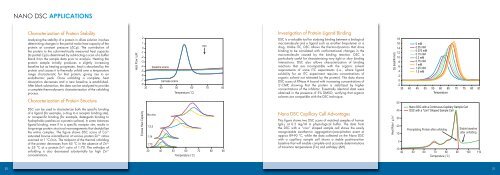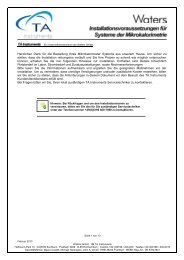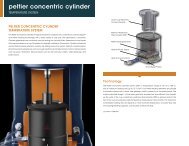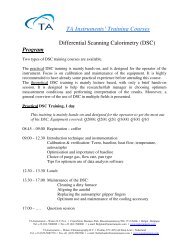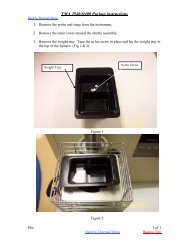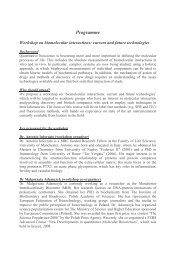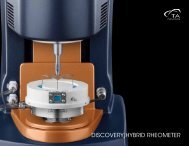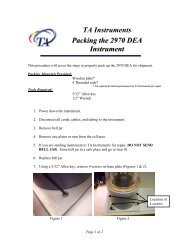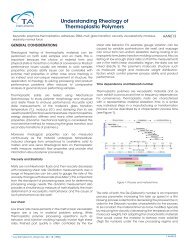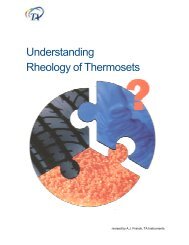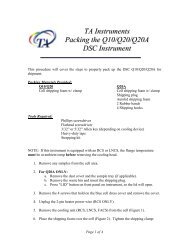Nano DSC Brochure - TA Instruments
Nano DSC Brochure - TA Instruments
Nano DSC Brochure - TA Instruments
You also want an ePaper? Increase the reach of your titles
YUMPU automatically turns print PDFs into web optimized ePapers that Google loves.
nano <strong>DSC</strong> aPPliCatioNS<br />
Characterization of Protein Stability<br />
Analyzing the stability of a protein in dilute solution involves<br />
determining changes in the partial molar heat capacity of the<br />
protein at constant pressure (∆Cp). The contribution of<br />
the protein to the calorimetrically measured heat capacity<br />
(its partial Cp) is determined by subtracting a scan of a buffer<br />
blank from the sample data prior to analysis. Heating the<br />
protein sample initially produces a slightly increasing<br />
baseline but as heating progresses, heat is absorbed by the<br />
protein and causes it to thermally unfold over a temperature<br />
range characteristic for that protein, giving rise to an<br />
endothermic peak. Once unfolding is complete, heat<br />
absorption decreases and a new baseline is established.<br />
After blank subtraction, the data can be analyzed to provide<br />
a complete thermodynamic characterization of the unfolding<br />
process.<br />
Characterization of Protein Structure<br />
<strong>DSC</strong> can be used to characterize both the specific binding<br />
of a ligand (for example, a drug to a receptor binding site),<br />
or nonspecific binding (for example, detergents binding to<br />
hydrophobic patches on a protein surface). In some instances<br />
ligand binding, even if to a specific receptor site, results in<br />
long-range protein structural rearrangements that destabilize<br />
the entire complex. The figure shows <strong>DSC</strong> scans of Ca 2+<br />
saturated bovine a-lactalbumin at various protein:Zn 2+ ratios<br />
scanned at 1 °C/min. The midpoint of the thermal unfolding<br />
of the protein decreases from 65 °C in the absence of Zn 2+<br />
to 35 °C at a protein:Zn 2+ ratio of 1:70. The enthalpy of<br />
unfolding is also decreased substantially by high Zn 2+<br />
concentrations.<br />
Heat Flow / µW<br />
2<br />
1<br />
0<br />
-1<br />
-2<br />
-3<br />
-4<br />
-5<br />
-6<br />
baseline scans<br />
-7<br />
barnase scans<br />
-8<br />
30 40 50 60 70 80<br />
Excess Heat Capacity<br />
No zinc<br />
1:3.5<br />
1:14<br />
1:70<br />
Temperature (˚C)<br />
exo<br />
30 40 50 60 70 80 90<br />
Temperature (˚C)<br />
Investigation of Protein-Ligand Binding<br />
<strong>DSC</strong> is a valuable tool for studying binding between a biological<br />
macromolecule and a ligand such as another biopolymer or a<br />
drug. Unlike ITC, <strong>DSC</strong> allows the thermo-dynamics that drive<br />
binding to be correlated with conformational changes in the<br />
macromolecule caused by the binding reaction. <strong>DSC</strong> is<br />
particularly useful for characterizing very tight or slow binding<br />
interactions. <strong>DSC</strong> also allows characterization of binding<br />
reactions that are incompatible with the organic solvent<br />
requirements of some ITC experiments (i.e., where ligand<br />
solubility for an ITC experiment requires concentrations of<br />
organic solvent not tolerated by the protein). The data shows<br />
<strong>DSC</strong> scans of RNase A bound with increasing concentrations of<br />
2’-CMP, showing that the protein is stabilized by higher<br />
concentrations of the inhibitor. Essentially identical data were<br />
obtained in the presence of 5% DMSO, verifying that organic<br />
solvents are compatible with the <strong>DSC</strong> technique.<br />
<strong>Nano</strong> <strong>DSC</strong> Capillary Cell Advantages<br />
This figure shows two <strong>DSC</strong> scans of matched samples of human<br />
IgG 1 at 0.5 mg/ml in physiological buffer. The data from<br />
the <strong>DSC</strong> with a “coin” shaped sample cell shows the easily<br />
recognizable exothermic aggregation/precipitation event at<br />
approx 89-90 °C, while the data collected on the <strong>Nano</strong> <strong>DSC</strong><br />
with a capillary sample cell shows a stable post-transition<br />
baseline that will enable complete and accurate determinations<br />
of transition temperatures (Tm) and enthalpy (ΔH).<br />
Cp (kcal/K-mol)<br />
Heat Rate / µJ s -1<br />
18<br />
16 0 mM<br />
14<br />
12<br />
10<br />
8<br />
6<br />
4<br />
2<br />
0.05 mM<br />
0.075 mM<br />
0.15 mM<br />
0.3 mM<br />
0.75 mM<br />
1 mM<br />
1.25 mM<br />
1.5 mM<br />
0<br />
-2<br />
35 40 45 50 55 60 65 70 75 80 85<br />
Temperature<br />
50<br />
40<br />
30<br />
20<br />
10<br />
0<br />
<strong>Nano</strong> <strong>DSC</strong> with a Continuous Capillary Sample Cell<br />
<strong>DSC</strong> with a "coin" Shaped Sample Cell<br />
Precipitating Protein after unfolding<br />
Stable baseline<br />
after unfolding<br />
-10<br />
40 50 60 70 80 90 100 110<br />
Temperature (˚C)<br />
20<br />
21


